Fri, Nov 3 – Start
Amazon Cruise - The Amazon River is the longest river in the world. At an average discharge of about 7,400,000 cu ft/s, which is
greater than the next seven largest independent rivers combined—the Amazon
represents 20% of the global river discharge to the ocean. The Amazon basin is the largest drainage basin
in the world, with an area of approximately 2,720,000 square miles. The portion of
the river's drainage basin in Brazil alone is larger than any other river's
basin. The Amazon enters Brazil with only one-fifth of the flow it finally
discharges into the Atlantic Ocean, yet already has a greater flow at this
point than the discharge of any other river. WOW!
We are up and ready to go by 8:30 but check out isn't until noon and we've been told that we can stay in our rooms until two if we want to; but we are antsy and ready to go. We have a nice breakfast again, and then wander around for a while and by noon we are ready to leave. The clerk at the front desk calls a taxi for us and then is nice enough to walk out with us to tell the driver where we want to go and he found out how much it would; plus we were told there is an additional fee for entering the port and he told us how much that was also. Great help - thank you. We are on our way. We arrived before the 2:00 time frame, but we are helped down the gang plank and they take our bags for us and place them in the foyer.
We are provided juice and pastries, nothing gluten free, so we ask about this and are told "no, no it is all free". This sets the tone for the whole trip as far as gluten free is concerned. As I have done in the past, I picked and chose and hoped that I was right about what I was choosing. Dinner is not until 8 p.m. but we are allowed to go up to our rooms around 3 p.m. It's a nice room with a small balcony, efficient bathroom and a comfortable looking bed.
We have a tv and there is a program on it describing our cruise, but unfortunately no English subtitles. Oh well. Looks like fun. We hang out for the rest of day up on the top deck - there are three floors of rooms and then the forth deck is wide open and has a pool on it and a bar and buffet area. We are now heading up the Amazon river - yeah! Our dinner mates are an English couple who will be on for only the first half of the trip, Robert and Ann from London; a Floridian couple, George and Charlene who will be with us the entire time, and two friends travelling together, Patsy and Ann from Henderson, Nevada. This is our table for the next several days. Dinner is a buffet and we have some wonderful choices of local fish (not fried), meat, soups, salads and oh .so many deserts/
We have been provided with a schedule of what to expect each day - breakfast at 7; boat trip at 8; another boat trip at 2 and the rest of the day is on our own - usually there will be an entertainment of some sort every other day; and there will be a night excursion to go see the gators.
Day 2 - We are up early watching the day start up on the top deck - they make really good coffee up here; not so much in the dining room - tastes like chlorine. We have never encountered such issues with coffee - what gives? So we enjoy the coffee and the slowly drifting boat cruising the Amazon - this is so awesome!!! I guess nobody else wanted to get up early. We meet a young man, Paricles (please forgive me for the spelling) who seemed to be of like mind as us. But other than a couple of other people we have the ship's top deck to ourselves. We wander done for breakfast - we attempted the eggs, but again they aren't to our liking, so we found the oatmeal - it is dry and in a bowl and so we put it in our bowls and went over to the hot water spigot (for making tea) to pour over it and added some nuts and fruit and we are good to go. We didn't ever really find any milk - they had hot milk for your coffee, so we had the waiter put it on our cereal - he looked like we were nuts, but then so did the other waiters when we were making our oatmeal. I wander what they do with the oatmeal if not use it as a cereal.
Our first trip out are in small boats
- our English speaking group is the last to load and we have our own boat. There seems to be a major group of locals from Rio; and a bus load of rowdy Germans and the eight of us. The first thing we are explained is that the locals refer to the river as Solimões only in the area around the Manaus area. Further up the river it is back to the Amazon and below Manaus it is referred to the Amazon. But in this area, it is the Solimões and the area we are in is the "Amazonas", so that might be why. But from here on in we will refer to it as the Amazon only.
So we are heading to a local farm and along the way we see our first sighting of a pink dolphin. They are truly pink and have a much longer nose than the blue dolphin, which is the other dolphin in these waters. As we are traveling along the river, I am impressed at how
wide this river is, we see a lot of people going around in their fishing boats - the motor is a vertical shaft motor that they hand steer - picture a very long immersion blender and you have a good idea of what we are seeing. They are very loud, so no sneaking up on you in the dark, which is a good thing because they don't seem to use lights at night - we arrived at the farm and climb up the hill to the farm - it is about 50 to 60 feet above water level, and has a
wooden type walk way up to the house. Our guide is Conrad (last name) and a really nice guy who speaks fluent English. He walks us around this small farm (only a few acres from what we can see; but more than enough to support this family of seven).
They are growing lemon grass (smelled so good), cilantro (they called it by a totally different name and we told the English that it is coriander - which is what they call our cilantro - it's all the same, just different names); garlic, many vegetables and acai berries - everybody seems to grow these berries - wish I could have taken home a suitcase full - these things cost a fortune in the US. They use the berries for all sorts of things, not just juice. They also grow there own flour in they grow what we know as the Yucca which produces the tapioca starch/flour. Everyone pretty much grows and dries this product. These people seemed very self sufficient, but I guess you have to be when you live out in the jungle. They fish, which is their mainstay for protein and then have their garden for everything else. Plus, they have all sorts of beautiful fruit trees, what looks like a coconut, but it is cacao, mangoes, papayas, bananas and lots of other fruits. We were invited into the house which is then again up a flight of steps - it's built on stilts even though it is already 50 or 60 feet above the water level. There was an old singer sewing machine with a foot pedal outside the house - it looks like it is well used. We weren't told how long ago electricity came, but it is government sponsored and only costs 10 rios a month - this is about $3.50. Can you imagine!
School is mandatory for all children - this way they get their meals at school, the families are paid for their children attending - no school, no money. They are also provided with the internet and many students do school through this source.
Fishing is their main source of food, but they are only allowed to fish for several species for a two year period. Then they
leave those fish alone and fish several other species. This way they don't eliminate any species.
At one time the boats that cruised these waters were built three and four stories high, so they were taking a lot of the wood - the government put a stop to that and now boats can only be
one story with a deck. Most homes are river boats, so when the rainy season starts they don't have to worry about being flooded they just rise with the river. We were told that the river has risen as high as a 100 feet, but normal is around 50-60 feet. Can you imagine the amount of water that is. The dry season is for six months and the wet season six months
This afternoon we had a choice, we could do a boat ride in search of critters or we could go piranha fishing - I really wanted a picture of a piranha being caught, but neither of us had any desire to go fishing, so a boat trip it is. We saw some birds but we are still at the end of the dry season and the water hasn't risen enough for us to see into the tops of the trees where the birds roost. We have encountered lots of white egrets (they call them herons; we haven't figured this out. We spent about an hour or so wandering around, but didn't really see much of anything. Oh well.
There was a talk in the afternoon about the fruits of the area, but Jefferson is enthusiastic about talking with the Germans, and kind of forgets to translate into English what he is saying, so we didn't get a lot of information. Someone must have said something because the future talks were given at two different times and our was always an English only talk. Luckily there are a lot of people who do understand English, just don't speak it, so it was worth Iberostar's effort to put it on for us.
Our guide Conrad has guided tours for National Geographic, Discovery Channel and is extremely knowledgeable of these waters. He also told us he spent a week with David Beckman showing him around. It seems the fishing in these waters are quite awesome and a lot of people come down here to do so. One of the other things he told us, which helped us understand the difficulty with the language barrier is that only 10% of the people on these cruises are foreigners; they get very few English speaking, and the other 90% are usually locals from Rio or other places in Brazil. He told us that most of the foreigners go to the Jungle Lodges, which is where one of our dinner mates will be going when they disembark later this week.
We had a very late dinner - dinner is not served until 8 p.m. - bummer, this is really late for us. There is no entertainment tonight, so I am off to bed and Russ is going out on the Caymen search. I have no desire to be out there with all the bugs - it's at night time that they seem to show up or so we've been told. Russ came back and said there were very few bugs, mainly up by Conrad. They were in search of caymens, which are a variety of the Crocodile / Alligator - we never really did get a good explanation on this - they look like a miniature alligator, but I
didn't think they had alligators that far south. Cayman hunting consists of cruising along in the dark and flash the light along the edge of the water and then they will see the red of the caymen's eyes and then Conrad attempts to catch it. Why, we have no idea. It's a little scary watching him attempt this. Anyway, Russ seemed to enjoy the trip.
One of the things that Conrad told us was how some of the fish like to eat fruit and when the waters get high the electric eel will swim to the tree and shock it and the fruit falls into the water, then when the fish goes for the fruit the eel eats the fish. Cool! Another thing we learned is that, again when the waters are high, certain fish will jump out of the water, land on some leaves and lay their eggs, then the male fish will jump up and fertilize them and then the lady wanders away and he stays and makes sure that the eggs are well watered and taken care of. Once they hatch they fall back into the water.
DAY 3 - This morning we are up early for our coffee on the top deck and then we get an early morning ride to see the sun rise up over the Amazon - it was a great experience and I'm glad we did it. We were out for an hour looking again for birds, but still nothing more than some egrets and a couple of herons - real ones.
The next adventure was a jungle hike. The waters are rising so we can do this hike, that only a week ago they couldn't because the boats couldn't get into the passage. We have Jefferson as our guide today. He took us up the side of a hill, we are definitely hiking in the jungle - our biggest obstacles are watching were we put our hands - some of the trees are very thorny - I found this out the hard way as I tripped over a root and into the
thorns - ow! We were definitely doing a cross country tour - there is no path that we are following, he is just beating his way through the jungle with a small machete - it did have a compass on top of the handle so we assumed (ha ha) that he knew where we going - but we all made it to the top about 15 minutes later. Thankfully the rest of trip was pretty flat, albeit quite a lot of roots to trip over and in. He kept showing us different trees, but they all seemed to be a different version of a cacao tree. This is not a misspelling. The cacao tree is what cocoa comes from; the word itself was originally found in the Olmec language, then passed on to the Mayans and then the Spanish took the word and changed it to the current spelling which is cocoa. So, we were told there are five different type of the cacao tree, but if you've seen one you've seen them all. We also saw some rubber trees further in our trip, but by now we are being drenched - it opened up on us shortly after we got to the top of the hill. We wander around for another 45 minutes - no matter which way we went we seemed to have to turn back - the first time because hunters (no not head hunters) were in our path and Jefferson said he had encountered them before and they told him to stay out of the way - ok; the second time we turned around a tree was on the path and we couldn't get around and then we all thought we were headed somewhere and he totally turned us around and we went back to the boat. We never did see any monkeys or birds; we could hear them but we never spotted any- even Russ with his good eyes couldn't see anything. I did use the facilities - there were plenty of trees to squat behind - but I can tell you I was very leery as to where I was putting my hands and what I was squatting over. We finally made it back to the boat and this time he found the path and we slid down the hill and crawled back on the boat. Now that was an experience!
On our way out of the waterway we encountered a house boat towing a fishing boat - there was no room for both of us so we backed up quite a ways to allow it to go through - obviously word is out that this passageway is now open. We saw a rainbow on our way back - it has now stopped raining and we are drying out fast.
Our afternoon trip was first to the meeting of the waters - this is where the Amazon meets the Rio Negro (which is the largest tributary into the Amazon). The Rio Negro has a ph level of 4.6 and the Amazon is 6.2, so most of the fish that are in the Amazon do not survive in the
Rio Negro. It was really cool feeling the temperature difference. The Rio Negro was about 10 degrees warmer than the Amazon. But the most important factor is that these two waters do not mix at this point. The waters run along side of each for almost four miles without mixing You can see a very definitive line between the two waters. This is due to the differences in temperature, speed and water density of the two rivers. The Rio Negro flows at near 1.2 mph at a temperature of 82 °F, while the Amazon flows at 2.5–3.7 mph at a temperature of 72 °F. We will be stopping to see it again in the morning and from the top of the ship we should be able to get some really good shots.
Our next stop is at a floating shopping center and restaurant - understand the shopping center is not what you and I would picture. It is just a floating building with a restaurant on it and they
provide lunch to the locals for a small fee - I guess if you are fishing all day you get hungry and need a place to eat. They had set up all of their crafts for us to buy - we found a beautiful Native Mask that we just couldn't leave behind - and then we headed up another hill to go look at the large lily pads. Unfortunately there were only a few lily pads and they had seen a better day - we were told that as the water gets higher they blossom and float out into the lake and are quite big. The area that we walked through to get there would normally be under 50 feet of water and they would come in by boat to see the lily pads.
Conrad saw some monkeys and so did some of the others - we saw nothing. We saw
some tree branches moving but that was about it. Still no macaws or parrots, although we did see some parrot dots way up in the trees yesterday. We never seem to have the binoculars with us when we need them. We got back and took our second shower of the day.
Dinner tonight was a Gala affair - nothing we read said anything about dressing up for a
special dinner - we have the clothes with us but we weren't about to unpack the other suitcase to get them out - and after the day we had I had no enthusiasm for dressing up. It was a feast though, with beautiful fruit carvings - they may be the only birds we actually get to see! After dinner there was a fantastic floor show - a group of dancers demonstrating all of the different Brazilan cultural dances. Fantastic!
DAY 4 -
This morning we were up
early for our coffee and then to view the Meeting of the Waters – you get a
much better view and understanding from the top deck of the ship. The water was so smooth this a.m. and it is
so impressive to see these two waters flowing between each other.
Today we have no trips as this is the end of the first half of our trip, so
we are back in Manaus to unload and pick passengers. It seems like there is only about 30 of us
who are doing the whole eight day trip.
Once the departing passengers have left we decide to go into town and check out some
of the things we weren’t able to do when we had our city tour. George is joining us this morning so we are
meandering our way through town. It is a
busy day this a.m. in town. You would
think that it was a Saturday, but it isn’t, it’s Monday.
All the local shops are open and so we wander
down the streets checking things out. It
is a nice day and we are enjoying this walk, especially since we seem to be the
only tourists on these streets, the rest of them appear to be locals. We finally wandered over to the Craft
Building (this was the big building we toured earlier but had no time to shop
in). We are in search of a magnet that
says Amazon. We find nothing. They have lots of magnets that say “Manaus,
Brazil, Amazon; but nothing that we want.
We finally find a pink dolphin magnet an asked the shop keeper if she
would print Amazon on it. Now we had to
go through whether we wanted Amazonas or Amazonia – we had no idea what the
difference is or was and so went with Amazonas
we did pick up a magnet of Brazil – a large
Macaw – sure wish we could see the real thing!
The heat is beginning to get us down so we stopped for a soda and then
headed back to the boat. We took a dip
in the pool before all the newcomers got on and then went and had lunch and
hung out on the top deck watching the day go by. Our ship left about 6 p.m. and we cross
underneath the bridge – it is gorgeous all lit up –
At dinner tonight we discover how packed this boat is. We must be starting into the “high”
season. It is so loud and noisy you can’t even hear
yourself think. When we sat at dinner we
noticed that a sign had been placed on our table – reserving it for us English
speaking people! We discovered that
there are a lot more Americans/English speakers on the boat this trip.
Our trip the next several days will be on the Rio Negro.
DAY 5 - We are up early again for
our coffee, but our guy is not behind the bar anymore. I asked for a couple of cups of espresso and
the new guy just pointed to the coffee pot; I said no I want espresso, and he
again pointed to the pot. What was in
the pot was not espresso, and again it is chlorinated, but not nearly as much
as the coffee in the dining room. We had
met a couple from San Antonio, TX (Renee and Steve) and they joined us again this
a.m. for breakfast, but again you can hardly hear, let alone carry on a conversation.
We met two young girls that are working for the travel company Road
Scholar. They told us that the company
is looking into offering trips on the Amazon and so they are here for a couple
of weeks to check out the different lines and also the day cruises. What fun that would be and the company is
covering all their costs – where were they when I was young – that would have been
an awesome career.
Another young man we have met is Piracles; he has been on the trip this
whole time but we have not had an opportunity to speak with him. He is from Rio and is here on the trip with
his Mom and Grandmama. When we first met
them, we thought his mom was his girlfriend – wow! He is very excited about having the three
generations together. What a sweet young
man.
Our morning tour was with Andre (he is the boss). We had a boat, full this time, of all English
speakers. It is looking like rain this
a.m. so we had no desire to do the jungle trek.
If we had known that Conrad was leading it, we might have gone. Anyway this is our first adventure out into
the Rio Negro. In this area, known as
the stream region, there are over 400 islands.
The trees that live along this river live mainly in sand and water –
like on the amazon they are underwater for half of the year, but unlike the
trees of the amazon, they grow in sand – amazing. The islands are quite small, but very pretty,
with nice sandy beaches – let’s hope the government keeps the developers out of
this area.
We were told that the Amazon and Rio Negro don’t always flood at the same
time. The Amazon can flood and actually
block the Rio Negro from flowing into the Amazon at the area around
Manaus. This was hard for me to picture
since it is water and how can one stream of water block another stream of water
– that would take some mighty strong flows, but we were told it does happen
more times than not.
The Rio Negros has several indigenous tribes that are kept secluded for
their protection; they do not want visitors/tourists who may carry disease
(remember in our country the Spanish bringing small pox and wiping out the
natives) – same thing. They also want to
keep their culture pure without having outside influences. We never did get the answer as to whether or
not these tribes were allowed to have the internet; since everywhere we go we
see it.
The land is protected by the government and the only way you can own land is
if it has been in your family for generations.
They are trying to keep the Amazon River Basin in its natural state; but
a lot of land owners are allowing the outside world to come in and clear cut
the property. There is nothing anybody
can do about it since the government doesn’t own that particular parcel of
land. As families die or leave the
government can buy out the family if the property goes up for sale – in fact,
they are the only ones who can buy the property.
We finally saw some pretty birds today.
There was several really bright yellow and black birds and we were told
there name, but it didn’t stick. Andre
said they are very similar to the mockingbird in that they will make sounds of
the forest and other birds to keep their predators away from them. They also always build their nests next to a
wasp nest; this is to keep the larger Macaws away since the Macaws do not like
the wasps.
As we are traveling around these islands Andre continues to fill us in on
the life of and on the Rio Negro. The
birds are not as plentiful on this river as they are on the Amazon due to the
higher Ph levels of the water which limits what species of fish can survive in
these waters. Therefore there are not an
over abundance of communities out here.
I mentioned that he said there were not as many birds, yet we have seen
more species of birds on this river than we did on the Amazon; this may have to
do with the fact that the water is rising and so we are getting up closer to
the trees.
If I haven’t mentioned it yet, Camens are similar to the crocodile and
alligators, but they are their own species.
Our afternoon boat ride was not until 5 p.m.
We were told that since it is getting darker that we may have a better
chance to see more birds coming in to nest for the night. We did see some parrots flying over us and we
saw some Macaws way up in the trees. We
are also looking for snakes – yuck!
Conrad finds some for us; we see the white tree boa, and later he finds
us a brown tree boa. We got pictures
but you can’t see anything – they are really small, skinny snakes that blend
into their surrounding so well you would think it was a stick you were seeing,
not a snake. Conrad also used his flash
light to find us some camens. You can
see them when the light reflects off of their eyes – they shine red. It’s weird – that’s all you see are these
tiny little red dots in the dark.
It was getting quite dark so after an hour or so we headed back in to the
boat. It was again nice – no mosquitoes
or other bugs, only up by Conrad when he was shining his light.
I think we have hit the seasons just right as far as the bugs are
concerned. We have not encountered any
bugs, not even flies. However, I think
if we had come on the trip a couple of weeks later the water would have been
much higher and we may have seen a lot more birds, monkeys and other critters. I don’t know if the bugs would have also been
more prevalent. But what we have seen so
far is awesome.
We have new dinner mates this evening, Lance and Mara, who are from
Canada. They will be our dinner mates
for the remainder of the trip. We have a
nice group, just wish we didn’t eat so dang late.
DAY 6 – It is another gorgeous day in the Amazon Basin. Today our boat trip is to an Indigenous Indian community. This is the only tribe on the Rio Negro that is allowed to have people visit. The tribe is the Kombeba tribe (Flathead). They received their name because they put a board on top of their head – apparently so they could identify
themselves from the other tribes in the area. The missionaries came through some 500 years ago and after the baptized the people they left and the people went back to their beliefs. Then in the late 1800s early 1900s the rubber barons came and utilized the tribes as slaves to produce rubber from the trees for them. The chiefs got rich but the people did not. After they left the tribes pretty much started to disappear. Nobody knows exactly why, they just slowly drifted off into the river life, leaving their heritage behind.
By the 1970s the government decided that they would like to bring them back. So they started locating the descendants of the tribe and are attempting to reestablish it. We really don’t get the gist of why, but just that this is what is happening in this area of the River. The land in this area is owned by the government, unless you happen to have a small piece that has been in family for generations, it is pretty much all the
governments. The reason the government has taken control of the land is too keep it from being clear cut. If the land belongs to you, you can do whatever you want with it, and a lot of the people who land are letting it be stripped clean – then there is nothing to keep the water from washing the side of the hill away We arrived at the island and received a tour through the school, we saw the dormitories from the outside (the children come in and stay during the week and then go home on the weekends). The government is funding this experiment along with Samsung. Again, not sure why! After Conrad gave us history of these people we went to watch the demonstration of a local dance put on by the school children, then they sang their national anthem. We were then told we could wander around – there was a Macaw on the patio with some kids and they started letting us put him on our arm and take pictures – yeah – our first macaw. There was also a parrot about but he didn’t look all that friendly so we left him alone. There was a craft market open for our benefit. We found a salad spoon set that had both the pink dolphin and the blue dolphin. We just had to buy them.
Our afternoon tour was a bust. We had Jefferson for our tour guide and as we are driving along he is pointing things out for us from the back of the boat – we are all facing forward so we have no idea where he is pointing and saying “over there” doesn’t work.
We are to go to the tapioca farm today and see how it is grown and made, but we drive around for an hour looking at pretty much nothing but trees and then when we get to the farm we are told by the farmer that all of the tapioca is gone and so therefore he can’t demonstrate for us. Great! They did have crafts for us to buy, but we were are all pretty ticked off, so we just went back to the boat and head back to the ship. However, since we were so late getting to the farm, we were late coming back and we hit some really rough water – our driver kept us near the shore and then when we were in sight of the ship he hauled butt and we made it safely. These guys really know how to drive and get us up close to sights.
In our travels we have seen some really interesting trees – one is actually a vine – a bird drops the seeds into the top of a tree and then the vine grows down to the ground. Quite cool! We have also been told that some of the local trees can grow to mature height in five years. We saw some that had only been planted five years ago and they were quite tall and full grown from all appearances. We had dinner and went back to our rooms and just relaxed.
DAY 7 – This morning’s boat trip is to a local beach where we will wash all the sweat off of us and soak in the water and then we are going over to swim with the dolphins. We didn't swim, we stood on a platform that is about three feet down and the local guide feeds the dolphins and makes them jump out of the water for the fish. It might have been a bit hokey, but having a dolphin swim between your legs is an experience I won’t ever forget. We had both the blue and pink dolphin swimming in and around us. Cool experience.
Our last boat ride was out to the outdoor rubber museum. Unfortunately it was extremely hot and humid this day and we are exhausted so we didn’t really retain all that much information. It’s pretty much the same story as the coal miners or any industry
where the rich get richer and the poor workers owe their homes and lives to the bosses. It was the same thing here, only the product was Rubber.
We got back and took a shower and headed up to the top deck to have a drink and relax for a while. Then we will redo the packing and hopefully have it evenly distributed. We didn’t bring our scale with us, so Russ is holding them both and judging if they are even or not. We later discovered he did a great job. We were under our 50 pound limit on each suitcase.
Dinner tonight is another Gala affair. We all lingered for longer than normal. The entertainment tonight was again as awesome as the last gala affair. We had some fantastic dancers come in and demonstrate the different dances of Brazil along with the native costumes. It was awesome. Also before dinner we got to listen to the flute player – all native type flutes and made of their native woods. He was awesome – I hope Russ got a video of him. We did get his dvd.
Our travels are just about over, one more meal tomorrow morning and then we are on our way.
DAY 8 – We got up early one last time and coffee up on the deck and watched the sun come up – we will miss this. It is so nice having a balcony to sit out on and to have the top deck pretty much to yourself. We again are seeing the meeting of the waters, but today the water is rougher than it was the first time we saw it, so we are grateful that we have had the chance to see it twice. This morning it was harder to see the dividing line, but we hang out for a while and say goodbye to the Amazon Basin. We have had a blast on this trip.
FY1 - If any one is interested in doing the amazon, before you go to the Iberostar page, I would highly suggest you check our main guide's website. It is: AmazonMonsterExpeditions.com. That's Amazon Monster Expeditions. I truly wish we had had the opportunity to find his sight before we left. He told Russ that he is not one of the regular guides on the Iberostar, but was filling in for cruise members who were taking time off. That was definitely our good fortune.

 Manacapuru, Amazonas, Brazil
Manacapuru, Amazonas, Brazil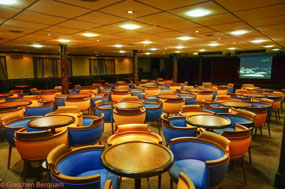
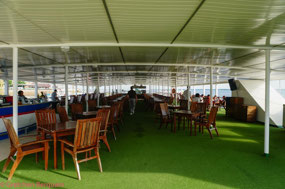

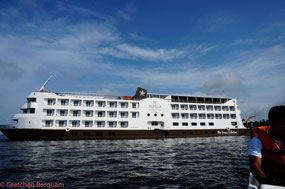
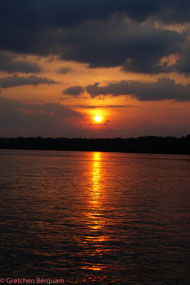
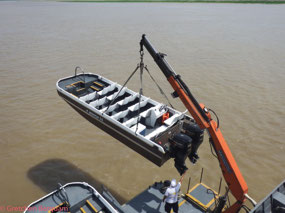
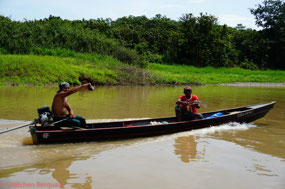
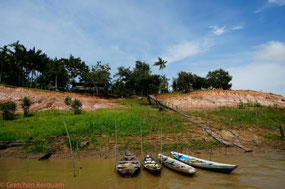
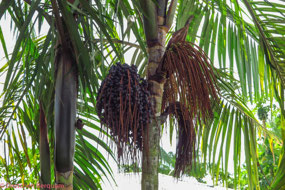

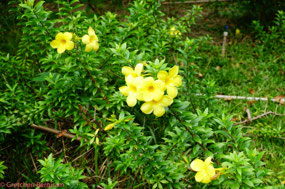
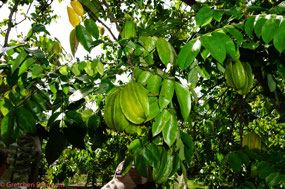
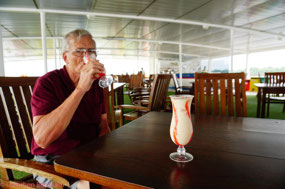
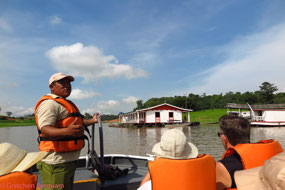
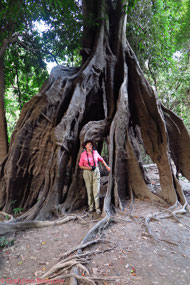
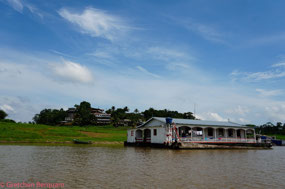
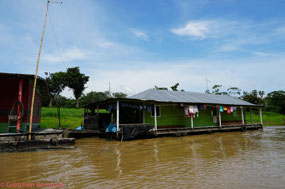
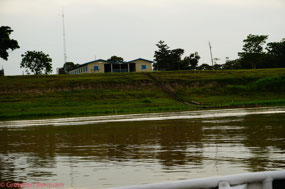
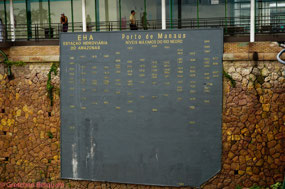
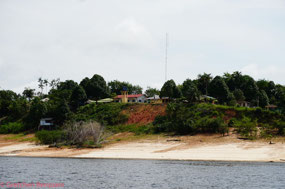
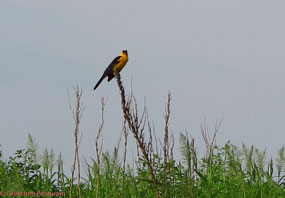
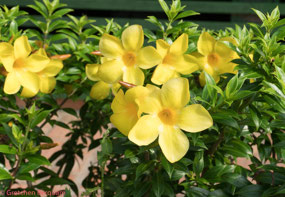
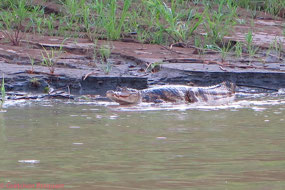
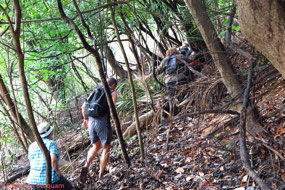
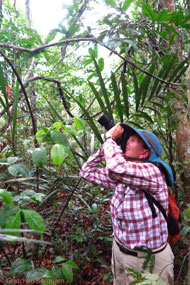
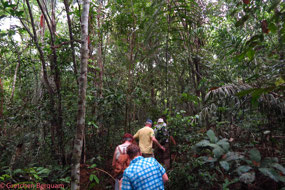
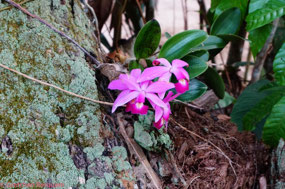
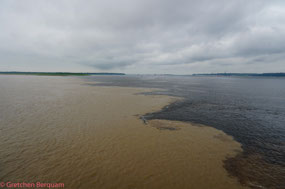
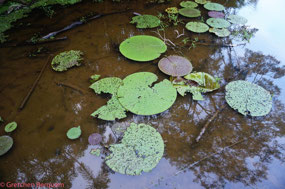
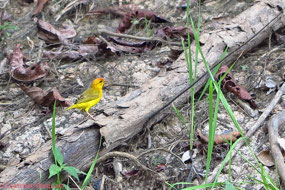
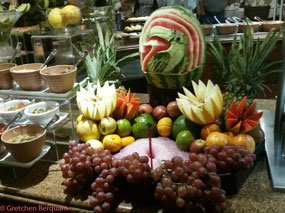
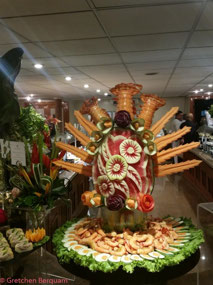
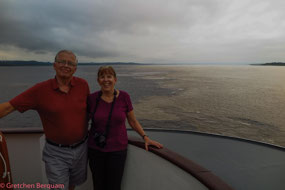
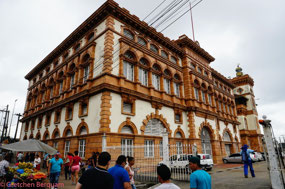
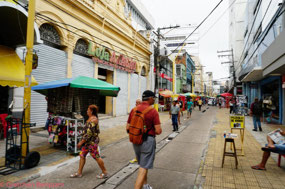
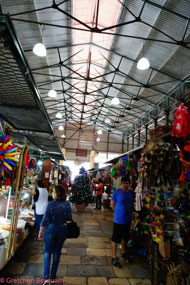

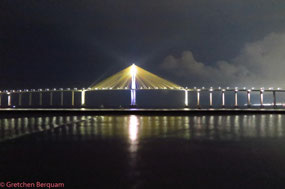
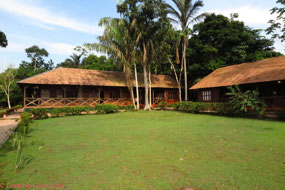
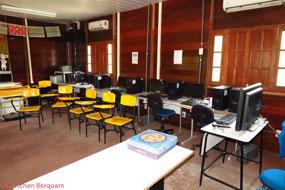
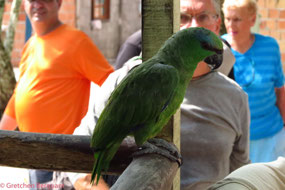
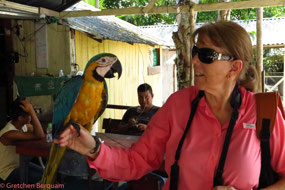
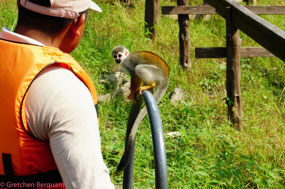
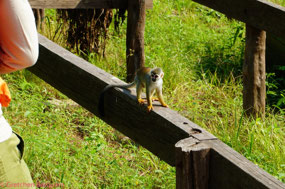
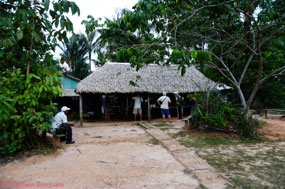
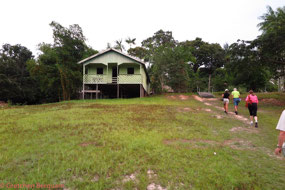
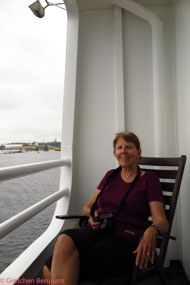
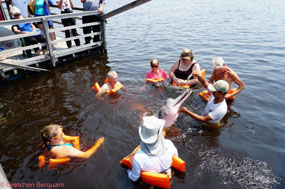
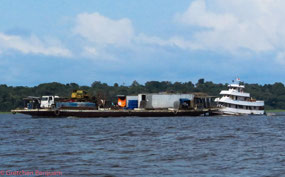
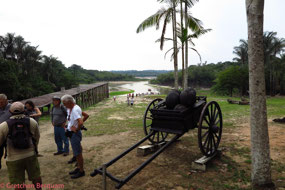

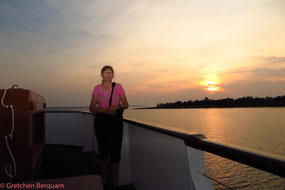










2025-05-22